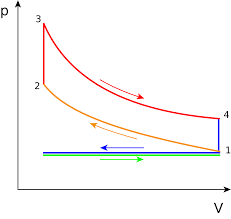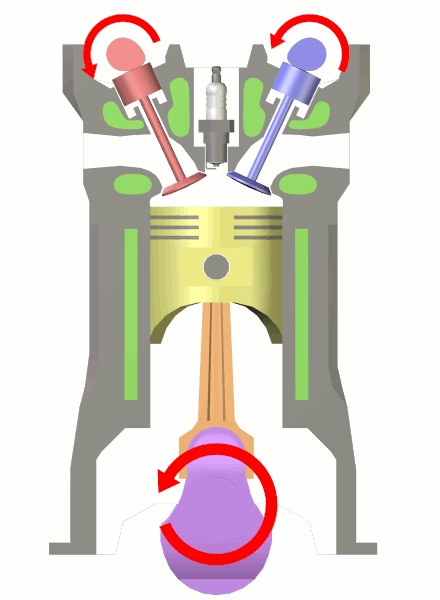THE SPARK IGNITION ENGINE; THE OTTO CYCLE AND HOW IT OPERATES.
The classification of engines according to fuel used have been known to be petrol and diesel-powered engines and many of us have learnt about how this engines work and their fuels burn in the combustion chamber. But what some of us don’t know about our engines is the way they operate, and the way fuel is being burnt this brings me to what I would like to discuss today.
Although both the petrol and the diesel engine operate on a thermodynamic cycle called the gas-powered cycle. But have you ever looked at your engine and wonder why you find a spark plug in your petrol engine and none in your diesel engine?
This is due to the difference in gas power cycle both the petrol and diesel engine operates on. The diesel engine uses what is known as the air compression ignition to cause combustion in the chamber this thermodynamic cycle this operates on is called the diesel cycle while the petrol engine operates on the Otto cycle. This is what I would be discussing today.
The Otto cycle
The Otto cycle is basically and well known to be associated with petrol engines only. The Otto cycle is one of the four types of the gas power cycle which are all thermodynamic cycles. The Otto cycle explains the how the spark ignition works in an automobile engine. The Otto cycle uses air as its working fluid that’s why it is referred to as the air standard cycle. Before this cycle can fully be explained, we must know or understand what really happens in the combustion chamber which is the actual spark ignition works.
The Otto cycle is an ideal cycle which the actual spark ignition engine works it assumes that there is no loss due to friction and viscous effect. The Otto cycle is also known as the constant volume cycle.
Brief history of the Otto cycle
The name cycle was named after a man called Nikolaus A. Otto. He succeeded in building a four-stroke engine in 1876 in Germany using a cycle which was proposed by Beau de Rochas in 1862.
Explaining the Otto cycle
Let’s take a four-stroke engine as our case study
a four-stroke internal combustion engine is that engine which its piston completes four strokes in the cylinder and the crankshaft completes two revolutions for each thermodynamic cycle. The Otto cycle can be explained by four irreversible processes. Using this diagram
1-2 isentropic process
2-3 constant-volume heat addition process
3-4 isentropic expansion
4-1 constant-volume heat rejection
Process 1-2 (isentropic process)
This process occurs when the piston moves from the bottom dead center to the top dead center compressing the air-fuel mixture.
Process 2-3 (constant-volume heat addition process)
Heat is being added to the combustion chamber as the spark plug ignites and adds fire to the compressed air-fuel mixture. Volume is constant at this process.
Process 3-4 (isentropic expansion)
The piston moves down as expansion occurs. The fuel burns at high pressure which forces the piston to move down.
Process 4-1 (isentropic process)
Heat is being rejected as the piston is located at the bottom dead center. The exhaust opens as the products of burnt fuel flows out.
ACTUAL SPARK-IGNITION ENGINE
The actual operation of the spark-ignition engine does not operate in the ideal environment as friction occurs and viscosity effects are being felt, therefore, there is a little deviation from the Otto cycle. this also can be explained using the following steps and the drawing.
THE COMPRESSION STROKE
In the transition to this stroke, both exhaust and intake valves are closed, and the piston is found to be at its lowest position (bottom depth center). When compression stroke is happening, the piston from its lowest position moves upward and compresses the air-fuel mixture already present in the chamber while both intake and exhaust valves are still closed.
POWER STROKE
Just before the piston reaches the top of the chamber, the spark plug located at the top of the chamber ignites the mixture which increases the pressure and temperature of the system. This high pressure pushes the piston down and causes the crankshaft to rotate and produce a useful work in the power or expansion stroke. At the end of this stroke, the first mechanical cycle is completed as the piston returns to the bottom dead center.
EXHAUST STROKE
By the time the piston is pushed down by the combustion in the power stroke, the combustion chamber is already filled up with products of combustion of fuel. The movement of the piston back to the top of the chamber (i.e. the top depth center) will, therefore, purge out these gases or products of combustion. During this stroke, the exhaust valve opens as the products of combustion are being purged out of the combustion chamber.
INTAKE STROKE
This denotes the end of another mechanical cycle (i.e. the second one) the piston moves back to the bottom of the chamber (i.e. bottom depth center) when this occurs the exhaust valve closes, and the inlet valve opens which draws in the air-fuel mixture for the thermodynamic cycle to start all over again. The pressure in the cylinder is above atmospheric pressure during exhaust and below during intake.
THE APPLICATION OF OTTO CYCLE
Many of us have several engines in our homes that use this cycle for their operation. The four-stroke engines are not the only one that operates on this cycle all petrol engines operate on this cycle. Some of these engines include; automobile engines, mowers, generator engines (petrol), and or an internal combustion engine that operates on petrol.
CONCLUSION
The petrol engine is quite different from the diesel engine due to the gas power cycle they operate on. As all petrol internal combustion engines operate on this cycle which was brought about by Beau de Rochas in 1862. The Otto cycle or constant volume cycle is an ideal air cycle which assumes that there is no friction and viscous effect. This cycle occurs in four processes and the ignition in a petrol engine is caused by the spark plug which ignites fire into the combustion chamber. This gas power cycle is a very important thing in engineering as it is found to be more efficient than the diesel engine.
Thanks for reading!
References
For further reading please use the links and get the books.
- thermodynamics chapter 8
- Thermodynamics: An Engineering Approach, 5th edition by Yunus A. Çengel and Michael A. Boles
Weight - Otto cycle
- The Otto cycle
- thermodynamic cycle
- petrol engine cycle
- mechanical Otto cycle
- pdf on gas vapor cycles


This post reminds me of a course i did some years back, "engineering thermodynamics" (the almighty thermo).
Well, the otto cycle has its advantages over the diesel engines but one major difference is that the diesel engine has more tractive power. (oh my, i can still remember!)
Yeah.. It was at least one of the interesting ones in the thermodynamic course.. Made me go through hell.
Haha, i can imagine you reminiscing on the "hell"
Am telling you bro.. Prof Akinbode made us go through that.
Certainly one of my areas of interest in thermodynamics. Very nice work you did on it.
Thank you @sogless for taking time to read and be here.
The Otto engines have contributed a lot. In Nigeria where there's electricity shortage, people rely on portable power generators. Most of these generators use Otto engines.
Thanks for letting us understand its principle of operation.
I agree with you. Many don't even know how their generators work or why it has a spark plug or even what combustion is.. I hope they can read this to learn a little about their engine. Thanks for reading.
How automobiles function is a thing of wonder and again what you explained right here is just a part of it. Engineers are amazing.
You really put a lot of work into this post. Thanks for sharing!
Thank you @aliyu-s. I am proud to be an engineer. And thanks for your kind words i hope to do my best next time.
Educative article. Is always good to bring forth this articles as to keep our minds refreshed. Though I didn't study mechanical Engineering but I have flare for it. Well done @adetola
Mechanical engineering.. Hmm it wasn't easy but it is interesting. Am sure you will enjoy it if you choose to go back and study it. Thank you for reading.
Yeah. Sure I will .
I would say this is quite refreshing. Brought back memories and knowledge gained during my MCE307 class.
Thanks for sharing this.
Thank you mr breezie for taking time to read through. I hope i did justice to the topic?.
This is well written... The momentum is well kept...
Keep writing.
Thank you sir.
U're welcomed